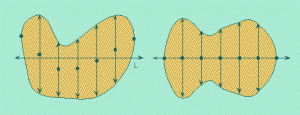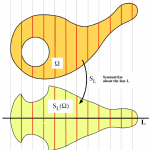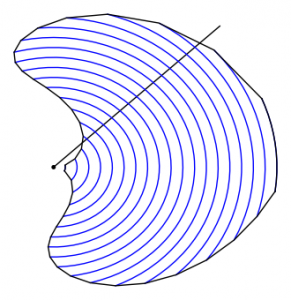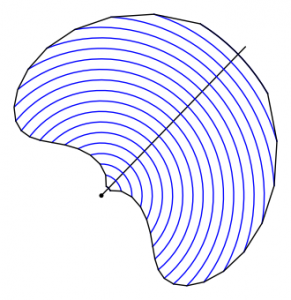Symmetrization
Write-up of a departmental faculty seminar, October 2, 2009.
Solutions to problems in geometry and physics and even in the social sciences tend to be symmetric. As prime example, the solution to the isoperimetric problem, which seeks the least-perimeter way to enclose given volume in R3, is a sphere, the most symmetric of all shapes. One way to prove this is to show that anything else improves as you make it more symmetric. For thousands of years, mathematicians have been looking for good ways to make shapes more symmetric and to prove that as they get more symmetric they “get better,” for example, enclose the same volume with less perimeter.
My favorite references are Burago and Zalgaller [BZ, §9.2] and Ros [R1, §3.2]. This talk is based on [MHH]. Gromov [G, §9.4] provides some sweeping remarks and generalizations, including most of our results.
1. Steiner symmetrization [St, 1838] replaces every vertical slice of a region in R3 with a centered interval of the same length, as in Figure 1. By calculus, the volume does not change, but one can show that the perimeter decreases (or remains the same).


Figure 1. Steiner symmetrization replaces every vertical slice with a centered interval of the same length. www.math.utah.edu/~treiberg/Lect.html
2. Schwarz Symmetrization [Sc, 1884] replaces every horizontal slice of a region in R3 with a centered round disc of the same area. Again, volume does not change, but the perimeter decreases or remains the same.
Figure 2. Schwarz symmetrization replaces horizontal slices with centered round discs. www.toy-library.com.au/quoits.gif, danbrunskill.blogspot.com/2009/03/imhotep.html, Gatlinburg Trail April 2017
3. Generalized Schwarz Symmetrization. Steiner and Schwarz symmetrization can be generalized to any product BxRn of a Riemannian manifold B with Rn, replacing every vertical slice in Rn of a region with a centered round ball of the same volume. Our two original examples wereR2xR1 (Steiner symmetrization) and R1xR2 (Schwarz symmetrization). More generally, one can replace BxRn with BxSn or BxF for any Riemannian manifold F in which balls about some fixed point are perimeter minimizing.
4. Warped Products. More generally, symmetrization generalizes to a warped product BxgF, in which each fiber {b}xF is scaled by a factor g(b), so that the metric takes the form
ds2 = db2 + g(b)2dt2.
A prime example is roughly to view R3 as a warped product R+xbS2, in which the fibers are concentric spheres about the origin parameterized by their intersection with the positive x-axis. Each such spherical fiber is scaled up by its distance b from the origin. Symmetrization replaces the intersection with each such spherical fiber by a spherical cap of the same area centered on the x-axis. This particular symmetrization is called spherical symmetrization. Spherical symmetrization is traditionally viewed as distinct from Schwarz symmetrization, but now we see that it is just generalized Schwarz symmetrization on a particular warped product.
Figure 3. Spherical symmetrization replaces the intersection with a sphere with a spherical cap. Image by Sean Howe.
5. Fiber Bundles. More generally, symmetrization generalizes to fiber bundles. By definition, a Riemannian fiber bundle M with base B is a Riemannian manifold together with a “projection” map P onto another Riemannian manifold B. Each inverse image P–1(p) is called a fiber. We will be interested in the case when the projection is a Riemannian submersion, which means that infinitesimally the restriction of P to the orthogonal complement of a fiber is an isometry, and when each fiber is a scaling of a fixed Riemannian manifold F. The simplest and most famous example is the Hopf fibration P:S3->S2 with unit circle fibers. Think of S3 in R4 = C2, which has isometries of the form
(z1, z2) -> (eitz1, eitz2) ,
simultaneous identical rotation in each complex line. The fibers of S3 are the orbits of these isometries. Even locally S3 is not a Riemannian product B2xS1; instead, nearby fibers spiral around a given fiber. And globally S3 is not even topologically the same as S2xS1.
Unfortunately there’s no way in general to define symmetrization in the fiber bundle, because there’s no B inside the fiber bundle for centering the symmetrization.* Instead, the symmetrization is defined in the associated warped product BxgF. It works under the additional hypothesis that infinitesimally horizontal translation scales volume.
Ros [R2] used fiber bundle symmetrization for Hopf fibrations to solve the isoperimetric problem in certain lens spaces.
6. Densities. More generally, symmetrization generalizes to densities [M, Chap. 18].
7. Open Question. Unfortunately, symmetrization does not seem to work for example in R2 with density exp(r4) = exp((x2+y2)2), because the horizontal translation does not preserve or scale volume. It remains an open conjecture that balls about the origin are isoperimetric. The conjecture applies to any log convex radial density on RN. See [RCBM, Conj. 3.12].
Acknowledgements. This write-up of a departmental faculty seminar is based on joint work with Sean Howe and Nate Harman [MHH], which began with the Williams College, National Science Foundation SMALL undergraduate research Geometry Group at the University of Granada, Spain, summer 2009. We would like to thank Vincent Bayle, Antonio Cañete, Alexander Díaz, Rafael López, Manuel Ritoré, Antonio Ros, César Rosales, and David Thompson for help and inspiration. We acknowledge partial support by the National Science Foundation (grants to Morgan and to the SMALL REU), the Spanish Ministerio de Educación y Ciencia (grant to Ritoré, Rosales, et al.), the University of Granada, and Williams College. We would be grateful for comments on our preprint [MHH].
References
[BZ] Yu. D. Burago and V. A. Zalgaller, Geometric Inequalities, Springer-Verlag, 1980.
[G] M. Gromov, Isoperimetry of waists and concentration of maps, Geom. Funct. Anal. 13 (2003), 178–215.
[MHH] Frank Morgan, Sean Howe, and Nate Harman, Steiner and Schwarz symmetrization in warped products and fiber bundles with density, arXiv.org (2009).
[R1] Antonio Ros, The isoperimetric problem, Global Theory of Minimal Surfaces (Proc. Clay Math. Inst. Summer School, 2001), Amer. Math. Soc., Providence, RI (2005), 175-207.
[R2] Antonio Ros, The isoperimetric problem for lens spaces, in preparation.
[RCBM] César Rosales, Antonio Cañete, Vincent Bayle, and Frank Morgan, On the isoperimetric problem in Euclidean space with density, Calc. Var. PDE 31 (2008), 27-46.
[Sc] H. A. Schwarz, Beweis des Satzes, dass die Kugel kleinere Oberfläche besitzt, als jeder andere Körper gleichen Volumens, Nachrichten Königlichen Gesellschaft Wissenschaften Göttingen (1884), 1–13.
[St] J. Steiner, Einfache Beweise der isoperimetrischen Hauptsatze, Crelle’s J. 18 (1838), 286-287.
*Note on Section 5 added March, 2011. Daniel John did the best you can to define symmetrization inside symmetric spaces of noncompact type.
Note: Steiner and Schwarz symmetrization fail for non-product densities f on Rn.
Note: For the ultimate analysis of equality, see Cagnetti et al., 2013. Earlier results on spherical symmetrization appear in Morgan-Pratelli [MP, 6.2, 6.4] and Chung et al. [C, 3.8, 3.9].
[C] Ping Ngai Chung, Miguel A. Fernandez, Niralee Shah, Luis Sordo Vieira, Elena Wikner, Are circles isoperimetric in the plane with density e^r? preprint (2011).
[MP] Aldo Pratelli, Existence of isoperimetric regions in Rn with density, Ann. Global Anal. Geom. 43 (2013), 331–365; arXiv.org (2011).





 Welcome to my blog. I also have a blog at the
Welcome to my blog. I also have a blog at the
Symmetrization: Schwarz symmetrization « Ngô Quốc Anh:
[…] Symmetrization (by Frank Morgan) Leave a Comment […]
14 May 2010, 3:54 amChristian Nolau:
Hi, I like your blog Frank Morgan » Blog Archive » Symmetrization and have saved it on Digg 🙂 !
bye,
14 December 2011, 3:07 pmChristian Nolau
Tomas:
Any list of open problems in symmetrization? The latest I could find is in “some topics in symmetrization” by A. Baerstein.
19 February 2015, 9:45 pmJan Peter Schäfermeyer:
Thanks for this instructive explanation of symmetrization methods. If Schwarz symmetrization can be compared to a stack of horizontal slices, would spherical symmetrization in R^3 then be like the layers of an ball shaped onion?
7 February 2017, 10:45 amhttp://www.mesuandrews.com/newsite/wp-content/uploads/2013/05/onion-with-layers-300×199.jpg
Frank Morgan:
Thanks Jan, yes, an onion composed of spherical caps of varying sizes.
7 February 2017, 11:38 amJan Peter Schäfermeyer:
To the best of my knowledge the spherical symmetrization was introduced by Polya and Szegö in their book “Isoperimetric Inequalities in Mathematical Physics” in 1951. I think it is ideally suited to spherical geometry and was used by Figiel, Lindenstrauss and Milman in their proof of the isoperimetric inequality on a n-dimensional sphere.
7 February 2017, 7:28 pmhttp://link.springer.com/article/10.1007/BF02392234
By contrast, Erhard Schmidt’s proof that was published in 1948 uses Schwarz
symmetrization and is much more cumbersome.
http://onlinelibrary.wiley.com/wol1/doi/10.1002/mana.19480010202/abstract